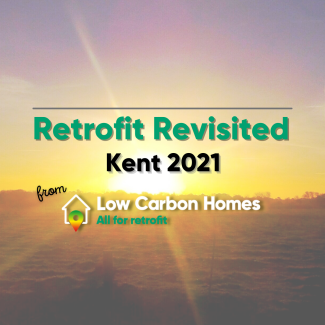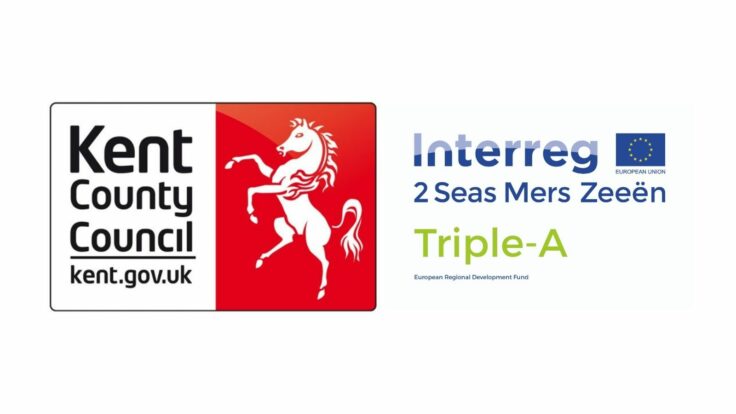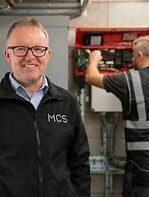Kent retrofit revisited

We reflect on Kent's retrofit activity, examined at our recent Low Carbon Homes online event
 “It’s a wonderful change. We don’t have to really worry about whether it’s going to be cold or hot, because our home is automatically self-regulating.”
“It’s a wonderful change. We don’t have to really worry about whether it’s going to be cold or hot, because our home is automatically self-regulating.”
It was wonderfully refreshing to hear John Tuck, a Kent householder, relay his experience of retrofit during our Kent retrofit conference.
“It was a no-brainer in my case,” John recalled, “because retrofit isn't costing me anything — in fact I’m going to be saving money — so I think that all in all it’s well worth having.”
John’s positive testimony really reinforced the point made by Councillor Susan Carey, Cabinet Member for Environment, Kent County Council, also speaking at our conference, that retrofit is as much a social commitment as it is an obligation to protect the planet.

“Over the next 30 years, most of the greenhouse gas emissions in Kent will come from buildings that already exist,” Cllr Carey pointed out, so tackling current housing emissions will be crucial for achieving the Kent and Medway ambition of net zero greenhouse gas emissions by 2050.
“It’s also the case,” Cllr Carey continued, “that some of our most vulnerable residents are living in cold, energy inefficient homes, which are expensive to run, worsen health problems and cause fuel poverty. So there are good reasons for us to take action.”
John’s house had been retrofitted through the ENGIE Zero carbon home retrofit model, a whole-house energy standard and funding refurbishment approach.

“We adhere to the innovative Energiesprong concept,” Andy Merrin, Head of Energy & Innovation at ENGIE explained to attendees. “We offer clients an end-to-end solution, where we can offer everything from design to performance guarantees to monitoring and feedback from residents to help them achieve their net-zero ambitions.
“The client benefits from a 30-year energy performance guarantee, meaning ENGIE will monitor and maintain products in the property for the lifecycle of the project and to ensure the customer continues to live in a home which is efficient, affordable and desirable.”
John’s testimony spoke volumes about just how effectively end-to-end retrofit approaches like ENGIE engaged residents, helping contractors and energy companies to understand customers’ needs.
The Triple A Project
We were delighted we could welcome speakers from the Netherlands to talk to our conference about how they engaged residents during the highly successful ‘Triple A Project.’ Lina Nurali, a Triple A Consultant and an energy adviser to the City of Antwerp, talked about how pop-up consultancies as a key instrument of engagement.

“Pop-ups serve as a physical point of contact where residents could get neutral and tailor-made advice when they consider retrofitting their house,” Lina recalled. “A local authority can collaborate with energy consultants or an energy corporation to organise follow-up visits and renovation coaching too, and it can be combined with virtual advice through a web portal.”
“Why did we set up pop-ups? Well, local authorities are aware there’s a lot of residents with energy questions. Many of them will already have different financial incentives for retrofit, but it doesn’t always reach homeowners who need it the most. By developing a pop-up centre, we as a local authority can come to them in their own neighbourhood,” Lina explained.
The Kent retrofit conference also included a Q&A session with our speakers. The Q&A chair, Graham Lock, asked Lina what her tip would be to Kent’s refurbishment industry to get retrofit scaled up.
“I think a personal touch with the homeowners and residents,” Lina said. “If you can go to the neighbourhood and have a personal chat with people and give them tailored advice, it’s an important first step to convince them to take low carbon measures.”
‘The lights will stay on’
Journeying from the Triple A Project to triple A batteries, Richard Partington, Managing Director at specialist battery suppliers AceOn gave a fascinating presentation on ‘Renewergy.’
Renewergy is a network of houses and flats, Richard explained, each operating as a micro-energy regeneration centre through the installation of solar panels and energy storage batteries. These are then virtually connected together through AceOn’s Smart Energy Management Platform.

“That way, we know how energy consumption patterns look within a household,” he explained, “and using an algorithm we optimise energy and minimise energy import into the site, and maximise carbon reductions. We can even trade any spare capacity to return revenue to the housing associations, councils, residents and tenants.
“The virtual power plant enhances energy independence, and we think we can maximise the utility of renewable energy generated at home to about 70%. That usage then translates into financial benefits for residents and tenants — a typical annual saving on a tenant’s elec bill could be over £350, rising to £581 by 2030, which clearly helps lift households out of fuel poverty,” Richard elucidated. “And most importantly, with Renewergy the lights will stay on!”
No such thing as a retrofit market
Russell Smith, Managing Director of Retrofit Works, continued on the theme of engaging stakeholders.

“At the moment we can’t really say there’s a mature market for retrofit,” Russell said. Instead, he explained, there were retrofit what he called ‘advocates’, ‘customers’ and ‘practitioners.’
“Retrofit Works is owned by retrofit advocates and practitioners,” Russell highlighted, “and, importantly, it’s set up to create local schemes which will engage with stakeholders — householders who are cold in their homes, landlords who just want to get stuff done, or green groups purely focussed on the carbon emissions.
“The issue is that all these people engage with different sets of advocates. Those advocates who join Retrofit Works can engage immediately with a supply chain which we’ve brought into the membership and whose credentials and certifications we can vet, while also ensuring contractors have the right tools to be able to do the job better.”
Andy Merrin agreed that the market was immature and required investment to stimulate demand. “Everyone’s waiting for the market to grow so they can start putting their own investment into it,” Andy said during our Q&A session. “We have just to keep the supply chain involved and positive, and maintain a regular dialogue with contractors so they understand what we’re doing and what our pipeline is like. That way they feel there is a need to invest in their staff.”
The quick route
Ian Rippin, CEO at MCS Certified, presented some options for businesses to equip their staff with skills in retrofit.

“A prerequisite for installing heat pumps is understanding how heating systems work. We at MCS have supported a heat pump installer qualification, a five-day course at the end of which you get an Ofqual certificate in heat pump installation. That’s a quick route into MCS and the Green Homes Grant.
“There are a number of training initiatives out there now which are partly or fully funded by the government like its Renewable Heat Installer Training and Support Scheme (RHITSS), which offers training and certification support, and 70% is funded.”
“Now we are also concentrating on apprenticeships,” Ian continued. “We’ve had approval for a new low carbon technician apprenticeship. It’s employer-led with MCS supporting it, and that goes live in September. We’ve had 120 installers join MCS for heat pumps in the last few months alone, so there’s a great deal of interest in the sector – quite rightly too.”
We were delighted to welcome back Lucy Pedler of the Green Register to talk about Futureproof – a reskilling initiative delivering skills to SME construction contractors in sustainable retrofit projects.

“The problem is,” Lucy pointed out, “that unless you’re inspiring young people to build sustainably they will just do what colleges always do, which is training them in traditional skills without looking at what the environmental impacts are.”
Graham Lock pointed to a CITB report discussed at our Liverpool conference which concluded that the biggest pool of potential future workforce is currently in education.
“School leavers are a hot pool of potential talent which could be persuaded and inspired to get involved with retrofit,” Graham said. “As we’ve seen with the Retrofit Get-In Project, it’s an exciting place to be where you can actually make a difference. Maybe there’s something there for Kent to think about in terms of engaging young people.
Building back better
Brian Horton of Kent and Medway Sustainable Energy Partnership who chaired the conference urged us to think of ways to get around these issues rolling out retrofit, urging us to consider the opportunities associated with the zero carbon agenda.

“Retrofit is such an important topic — at such a critical time — with the convergence of the challenges and opportunities presented by our responses to the Covid-19 pandemic, Brexit, climate change and the commitment to net zero,” Brian said.
“The focus is now increasingly on being able to take advantage of our shared desire to build back better post-Covid — and be part of a truly green-led recovery.”
Retrofit Glossary of Terms
| Term | Definition | Source |
|---|---|---|
| Deep /whole house retrofit | A complete retrofit approach where a house is treated as a joined-up system focusing on building fabric first, to strategies for heating, ventilation and cooling. This ensures that measures work together effectively and efficiently in the long-term. | TrustMark. 2020. Whole House Retrofit - A Consumer Guide. London: BEIS. |
| Fabric first | A retrofit strategy advocating for the building fabric improvements such as insulation as the priority measure. | Institute for Sustainability. 2012. Retrofit insights: perspectives for an emerging industry. London: UCL Energy Institute and Technology Strategy Board. |
| Fuel poverty | Fuel poverty is defined as households who spend 10% or more of their income on domestic energy use, meaning that they cannot maintain an adequately warm home. | Rosenow, J. 2012. Energy savings obligations in the UK – a history of change. Energy Policy. 49, pp. 373-382. |
| PAS 2030:2019 | PAS 2030:2019 is the industry specification (previously PAS 2030:2017) to which all energy efficiency installers must be certified and compliant with when carrying out energy efficiency measures under government initiatives. | TrustMark. 2020. Support for gaining Publicly Available Specifications (PAS) and Microgeneration Certification Scheme (MCS) Certification. [Online]. Available from: https://www.trustmark.org.uk/tradespeople/how-to-become-pas-mcs-certified#questions |
| PAS 2035:2019 | PAS 2035:2019 is the overarching specification for a framework of new and existing standards, promoting a whole house retrofit approach. Once an installer updates their certification to PAS 2030:2019, the PAS 2035:2019 requirements commence. | Elmhurst Energy. 2020. PAS 2035 for Installers. [Online]. Available from: https://www.elmhurstenergy.co.uk/pas-2035-installers |
| Retrofit | The retrospective fitting of building fabric improvements like insulation, low carbon HVAC, such as heat pumps and integrated renewables like PV panels, to improve the energy efficiency, health and comfort of a house and reduce its CO2 emissions. | Putnam, T. 2020. Grassroots retrofit: The role of community-led approaches in the UK's residential retrofit challenge. Master's thesis, University of Leeds. |
| Thermal comfort | Thermal comfort is defined as the condition of mind that expresses satisfaction with the thermal environment, and refers to a number of conditions in which most people feel comfortable. |
Camuffo, D. 2019. Temperature: A Key Variable in Conservation and Thermal Comfort. In: Camuffo, D. ed. Microclimate for Cultural Heritage. [Online]. 3rd edition. Amsterdam: Elsevier, pp. 15-42. |
Author

Article written by: Alex King | LinkedIn | Twitter @alexdpking